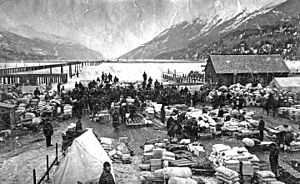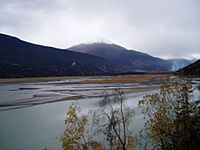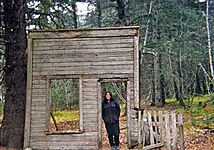Dyea, Alaska facts for kids
Quick facts for kids
Dyea
|
|
|---|---|

The Dyea waterfront during the Klondike Gold Rush.
|
|
| Country | United States |
| State | Alaska |
Dyea (/daɪˈiː/ dye-EE) is a former town in the U.S. state of Alaska. Today, it's mostly abandoned, a ghost town. A few people still live in the valley. Dyea is located where the Taiya River meets the Taiya Inlet. This spot is on the south side of the Chilkoot Pass. It is within the area of the Municipality of Skagway Borough, Alaska.
Contents
Dyea: A Gold Rush Ghost Town
During the exciting Klondike Gold Rush in the late 1890s, Dyea was a very busy place. Gold seekers arrived at its port by ship. From Dyea, they began their long journey to the gold fields. These gold fields were around Dawson City, Yukon, about 800 kilometers (500 miles) away.
The Path to Gold
The main route from Dyea was the Chilkoot Trail. This trail was a difficult path over the Coast Mountains. It had been used for a long time by the Tlingit people for trade. Many prospectors used this trail, hoping to find their fortune.
A famous person named Soapy Smith was known for controlling the nearby town of Skagway. He might have also had some control over Dyea during this time.
Why Dyea Became a Ghost Town
Dyea's port had shallow water, which made it hard for big ships. The nearby town of Skagway had a deep-water port. When the White Pass and Yukon Route railroad was built, it chose the White Pass Trail as its route. This trail started in Skagway. Because of this, Dyea was no longer needed and was soon abandoned.
How Dyea Got Its Name
The name Dyea was first used in 1886. This was when John J. Healy and Edgar Wilson opened a trading post there. Before that, only a small hunting and fishing cabin was at the spot. The name Dyea or Dei-yi likely came from the second part of "Jilḵoot Dei-yi," which meant "Chilkoot-owned Trail."
What You Can See Today
Today, Dyea is part of the Klondike Gold Rush National Historical Park. Not much is left of the old town. You can see some old building foundations and pieces of wood and metal. There are also three cemeteries. One of these cemeteries holds the graves of many people who died on the same day in 1898. They were caught in a terrible avalanche on the gold rush trail.
You might also see some wildlife when you visit Dyea. Brown bears, black bears, and eagles are often spotted there. Brown bears especially like to feed in the Dyea inlets during salmon spawning season, which is usually in July and August.
Chilkoot Trail and Dyea Site is a special U.S. National Historic Landmark.
Dyea's Population in the Past
Dyea appeared only once in the U.S. Census, in 1900. At that time, it was listed as an unincorporated village with 261 people. Since then, it has become part of the city of Skagway.
| Historical population | |||
|---|---|---|---|
| Census | Pop. | %± | |
| 1900 | 261 | — | |
| U.S. Decennial Census | |||





